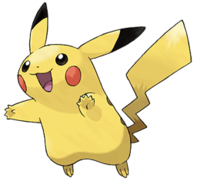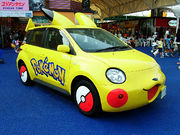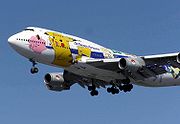Pikachu
 National Pokédex Arbok - Pikachu (#025) - Raichu |
|
| Series | Pokémon series |
|---|---|
| First game | Pokémon Red and Blue (1996) |
| Designed by | Ken Sugimori |
| Voiced by | Ikue Ōtani |
| Live action actor(s) | Jennifer Risser |
Pikachu (ピカチュウ Pikachū) is one of the species of Pokémon creatures from the Pokémon media franchise—a collection of video games, anime, manga, books, trading cards, and other media created by Satoshi Tajiri. As do all Pokémon, Pikachu fight other Pokémon in battles central to the anime, manga, and games of the series.[1] Pikachu is among the most recognizable Pokémon, largely because a Pikachu is a central character in the Pokémon anime series. Pikachu is widely considered the most popular Pokémon,[2] is regarded as the official mascot of the Pokémon franchise, and has become an icon of Japanese culture in recent years.
Within the world of the Pokémon franchise, Pikachu are often found in houses, forests,[3] plains, and occasionally near mountains, islands, and electrical sources (such as power plants), on most continents throughout the fictional world. As an Electric-type Pokémon, Pikachu can store electricity in its cheeks and release it in lightning-based attacks.[4]
Contents |
Concept and creation
Pikachu first appeared in 1996, among the 151 initial Pokémon mascots when Game Freak delivered the first-ever Pokémon game for the Japanese Game Boy.[5] The design and art direction for Pikachu were provided by Ken Sugimori, a friend of the creator of the Pocket Monsters game, Satoshi Tajiri.[6] Though not the first Pokémon created, Pikachu was the first "Electric-type" Pokémon created, conceived after the type was suggested to Sugimori and designed around the concept of electricity and the common symbol for lightning.[7] The name is a portmanteau of the Japanese words pikapika, an onomatopoeia for electric sparkling, and chū, which is the Japanese onomatopoeia for a mouse's squeak.[8]
In an interview, Pokémon Diamond and Pearl director Junichi Masuda noted Pikachu's name as one of the most difficult to create, due to an effort to make it appealing to both Japanese and American audiences.[9] The name is treated as a singular and plural noun in all incarnations of the franchise. In the series' anime, Pikachu has facial expressions, body language, and speaks by repeating syllables of its name, using different pitches and tones. Initially both Pikachu and the Pokémon Clefairy were chosen to be lead characters for the franchise merchandising, with the latter as the primary mascot to make the early comic book series more "engaging". However with the production of the animated series, Pikachu was chosen as the sole flagship Pokémon, in an attempt to appeal to female viewers and their mothers, and under the belief that the creature presented the image of a recognizable intimate pet for children. Its color was also a deciding factor, as yellow is a primary color and thus considered easier for children to recognize from a distance, and with consideration to the fact the only other competing yellow mascot at the time was Winnie-the-Pooh.[10]
The creators of the initial 151 Pokémon characters treated each design equally and allowed the fans to decide which creature would become the official mascot. The fans chose Pikachu, which led to its appearance in the anime alongside Ash.[11] Pikachu appeared as the starting character for players in Pokémon Yellow: Special Edition. In the early Pokémon video games, all Pokémon were portrayed by two-dimensional sprites, but in later releases appearance has been conveyed by 3D computer graphics. Throughout the games, Pikachu has been portrayed with no spoken dialogue.
Design and characteristics
Pikachu are small, mouse-like Pokémon that have short, yellow fur with brown markings covering their backs and parts of their tails. They have black-tipped, pointy ears and red circles on their cheeks, which are said to contain "electrical sacs".[3] Their tails are shaped in the form of a lightning bolt.[12] In Pokémon Diamond and Pearl, gender differences were introduced for some Pokémon; a female Pikachu now has an indent at the end of its tail, giving it a heart-shaped appearance.
The Pokédex, in the series, states that Pikachu forage for berries, roasting them with their electrical attacks before eating.[13] For already fallen berries and apples they use their electricity to roast and tenderize them. They are said to store electricity in their cheeks,[3] and by simply squeezing them they can discharge sparks, lightning bolts, or other forms of electricity. Discharging sparks and thunderbolts may be a sign of wariness from the Pokémon. An inability to discharge electricity, as occurs in the presence of a strong magnetic field, causes an illness with flu-like symptoms. Pikachu tend to gather in areas with high amounts of thunderstorm activity. When threatened, a group of Pikachu can generate an intense electrical output, and the electro-magnetic forces exerted by the resulting field can even produce short-lived, localized thunder and lightning storms.[14] They occasionally use an electric shock to recharge a fellow Pikachu that is in a weakened state.[15]
Pikachu evolves into Raichu via the use of a Thunder Stone; however, it is somewhat common for trainers to choose not to evolve their Pikachu. In the Pokémon Yellow game, using a Thunder Stone on a Pikachu makes it cry and refuse to evolve. From the second generation of the Pokémon games onward, Pikachu has an evolutionary predecessor, Pichu, which evolves into Pikachu after establishing a close friendship with its trainer.
Appearances
In the video games
In the video games, Pikachu is a low-level Pokémon, which stores electricity in its cheeks and is capable of firing said electricity in various forms of attack. It has appeared in all of the games naturally without having to trade. In the original games, Pikachu was inferior to its evolved form, Raichu, in terms of battling prowess; however, the popularity of Pikachu led to the introduction of the "Light Ball" item which allowed Pikachu to become a viable choice over Raichu in battles. The game Pokémon Yellow features a Pikachu as the representative Pokémon, featured on the box art and as the only available starter Pokémon. Based on the Pikachu from the Pokémon anime, it refuses to stay in its Poké Ball, and instead follows the main character around on screen. The trainer can speak to it and it displays different reactions depending on how it is treated. Another game centered around Pikachu is Hey You, Pikachu! for the Nintendo 64.[16] The player interacts with Pikachu through a microphone, issuing commands to play various mini-games and act out situations. The game Pokémon Channel follows a similar premise of interacting with the Pikachu, though without the microphone.[17] Pikachu also appear in almost all levels of Pokémon Snap. A Pikachu is also one of the sixteen starters and ten partners in the Pokémon Mystery Dungeon games. The 2009 Wii game, PokéPark Wii: Pikachu's Adventure, features a Pikachu as the main protagonist.[18]
Pikachu has also appeared in Super Smash Bros.,[19] Super Smash Bros. Melee,[20] and Super Smash Bros. Brawl[21] as a playable character.
In the anime

The Pokémon anime series and films feature the adventures of Ash Ketchum and his Pikachu, traveling through the various regions of the Pokémon universe. They are accompanied by a group of alternating friends, including Misty, Brock, May, Max, Tracey, and Dawn.
In the first episode, Ash Ketchum receives his Pikachu from Professor Oak as his starting Pokémon. New trainers are given a starting Pokémon; in Ash's homeland of Kanto this is often Charmander, Squirtle, or Bulbasaur, but Ash slept in and got Pikachu instead. At first, Pikachu largely ignores Ash's requests, shocking him frequently and refusing to be confined to the conventional method of Pokémon transportation, a Poké Ball. However, Ash puts himself in danger to defend Pikachu from a flock of wild Spearow,[22] then rushes the electric mouse to a Pokémon Center. Through these demonstrations of respect and unconditional commitment to Pokémon, Pikachu warms up to Ash, and their friendship is formed. However, it still refuses to go into its Poké Ball. Soon after, Pikachu shows great power that sets it apart from Pokémon, and other Pikachu, which causes Team Rocket to constantly attempt to capture it in order to win favor from their boss, Giovanni.[23]
Other wild and trained Pikachu appear throughout the series, often interacting with Ash and his Pikachu. The most notable among these is Richie's Pikachu, Sparky.[24] Like most other Pokémon, Pikachu communicates only by saying syllables of its own name. It is voiced by Ikue Ōtani in all versions of the anime.
In other Pokémon media
Pikachu is one of the main Pokémon used in many of the Pokémon manga series. In Pokémon Adventures, main characters Red and Yellow both train the same Pikachu at different times. Other series, including Magical Pokémon Journey and Getto Da Ze also feature Pikachu while other manga series, such as Electric Tale of Pikachu,[25] and Ash & Pikachu,[26] feature the most well known Pikachu belonging to Ketchum in the anime series.[25]
Collectible cards featuring Pikachu have appeared since the initial Pokémon Trading Card Game released in October 1996, including limited edition promotional cards. The character has also been used in promotional merchandising at fast-food chains such as McDonald's, Wendy's and Burger King.[27][28][29][30]
Legacy


As the face of the franchise, Pikachu has made multiple appearances in popular culture. In 1998, then-Mayor of Topeka, Kansas Joan Wagnon renamed the town "Topikachu" for a day as part of a promotional event for the franchise.[31] A "got milk?" advertisement featured Pikachu on April 25, 2000.[32] A Pikachu balloon has been featured in the Macy's Thanksgiving Day Parade since 2001.[33] Its appearance on 22 May 2006 during the morning rush hour was as part of a test examining parade balloon handling procedures.[34] The original balloon was flown for the last time publicly at the Pokémon Tenth Anniversary "Party of the Decade" on August 8, 2006 in Bryant Park in New York City,[35][36][37][38] and a new Pikachu Balloon that chases a Poké Ball and has light-up cheeks debuted at the 2006 Parade.[39] The balloon was chosen on an online survey at iVillage as the second-best balloon in the 2007 Parade.[40] Nintendo Power listed Pikachu as their ninth favourite hero, stating that while he was one of the first Pokémon, he is still popular to this day.[41]
During the first episode of the eleventh series of Top Gear, presentor Richard Hammond compared an image of the Tata Nano to one of Pikachu stating "they've saved money on the styling 'cause they've just based it on this."[42] In the third season of Heroes, Hiro Nakamura is nicknamed "Pikachu" by Daphne Millbrook, much to his chagrin. He is called this again by Tracy Strauss, after which he excuses himself before punching her in the face. A Pikachu spoof called Ling-Ling was a main character in the Comedy Central show Drawn Together. An image of Pikachu has also been featured on the ANA Boeing 747-400 (JA8962).[43]
Pikachu was ranked as the second best person of the year by Time in 1999, who called it "The most beloved animated character since Hello Kitty". The magazine noted Pikachu as the "public face of a phenomenon that has spread from Nintendo's fastest selling video game to a trading-card empire", citing the franchise's profits for the year as the reason for the ranking; behind singer Ricky Martin but ahead of author J.K. Rowling.[44] The character placed eighth in a 2000 Animax poll of favorite anime characters.[45] In 2002, Ash's Pikachu received fifteenth place in TV Guide's 50 greatest cartoon characters of all time.[46] GameSpot featured it in their article "All Time Greatest Game Hero".[47] In 2003 Forbes ranked Pikachu as the eighth top-earning fictional character of the year with an income of $825 million.[48] In 2004 the character dropped two spots to tenth on the list, taking in $825 million for a second straight year.[49] In a 2008 Oricon poll Pikachu was voted as the fourth most popular video game character in Japan, tying with Solid Snake.[50] The character has been regarded as the Japanese answer to Mickey Mouse[2] and as being part of a movement of "cute capitalism".[43]
A newly-discovered ligand believed to provide better visual acuity, discovered by Osaka Bioscience Institute Foundation (大阪バイオサイエンス研究所), is named "Pikachurin", borrowed from the nimbleness of Pikachu.[51] The name was inspired due to Pikachu's "lightning-fast moves and shocking electric effects".[52]
Notes
- ↑ "Pokémon Ruby and Pokémon Sapphire Review (page 1)". IGN. http://uk.gameboy.ign.com/articles/389/389660p1.html. Retrieved 2006-06-01.
- ↑ 2.0 2.1 Tobin, Joseph (2004) (PDF). Pikachu's Global Adventure: The Rise and Fall of Pokémon. Duke University Press. ISBN 0822332876. http://www.nordicom.gu.se/common/publ_pdf/87_Yearbook%202002.pdf#page=55. Retrieved 2009-06-09.
- ↑ 3.0 3.1 3.2 Pokédex: It lives in forests with others. It stores electricity in the pouches on its cheeks. Game Freak. Pokémon Diamond. (Nintendo). Nintendo DS. (2007-04-22)
- ↑ Sora Ltd.. Pikachu Trophy Information. (Nintendo). Wii. (2008-01-31) "When danger draws near, it uses tiny electric pouches within its cheeks to discharge electricity."
- ↑ Sora Ltd.. Pikachu Trophy Information. (Nintendo). Wii. (2008-01-31) "Appearances: Pokémon Red/Green (1996)"
- ↑ Stuart Bishop (2003-05-30). "Game Freak on Pokémon!". CVG. Archived from the original on 2008-02-08. http://www.webcitation.org/5VSJaR6xT. Retrieved 2008-06-04.
- ↑ "『ポケットモンスター』ˈˈスタッフインタビュー" (in Japanese). Nintendo. http://www.nintendo.co.jp/nom/0007/gfreak/page06.html. Retrieved June 6, 2009.
- ↑ "Japan: The True Meaning of". http://kotaku.com/347021/the-true-meaning-of-. Retrieved 2008-06-02.
- ↑ Noble, McKinley (2009-03-23). "Pokemon Platinum: Developer Interview!". GamePro. http://www.gamepro.com/article/previews/209340/pokemon-platinum-developer-interview-pt-2/. Retrieved 2009-06-09.
- ↑ Tobin, Joseph Jay (2004). Pikachu's Global Adventure: The Rise and Fall of Pokémon. Duke University Press. pp. 65–66. ISBN 0-822-33287-6.
- ↑ "Pikachu (Character Profile)". IGN. http://stars.ign.com/objects/920/920547.html. Retrieved 2008-07-29.
- ↑ Sora Ltd.. Pikachu Trophy Information. (Nintendo). Wii. (2008-01-31) "Its lightning-bolt tail and round cheeks are its trademarks."
- ↑ Pokédex: This intelligent Pokémon roasts hard Berries with electricity to make them tender enough to eat. Game Freak. Pokémon Stadium. (Nintendo). Nintendo 64. (2000-03-06)
- ↑ Pokédex: When several of these Pokémon gather, their electricity could build and cause lightning storms. Game Freak. Pokémon Red and Blue. (Nintendo). Game Boy. (1998-09-30)
- ↑ Pokédex: It occasionally uses an electric shock to recharge a fellow Pikachu that is in a weakened state. Game Freak. Pokémon Platinum. (Nintendo). Nintendo DS. (2009-03-22)
- ↑ Hey You, Pikachu! Nintendo.com Retrieved July 17, 2006
- ↑ Pokémon Channel IGN.com Retrieved July 17, 2006
- ↑ Nintendo officially announces PokePark Wii Joystiq.com Retrieved February 27, 2010
- ↑ Smash Bros.com Retrieved July 17, 2006
- ↑ Super Smash Bros Melee. detstar.com Retrieved July 17, 2006
- ↑ Smash Bros. Dojo! Pikachu Retrieved September 17, 2008
- ↑ "Pokémon - I Choose You!". Takeshi Shudō (writer). Pokémon. Various. September 8, 1998. No. 01, season 1.
- ↑ "Pokémon Emergency!". Takeshi Shudō (writer). Pokémon. Various. September 9, 1998. No. 02, season Indigo League.
- ↑ "A Friend In Deed". Shōji Yonemura (writer). Pokémon. Various. November 20, 1999. No. 78, season Indigo League.
- ↑ 25.0 25.1 "Animerica Interview Toshihiro Ono." VIZ Media. May 10, 2000. Retrieved on May 31, 2009.
- ↑ Ash & Pikachu (manga) Animenewsnetwork.com Encyclopaedia entry notes "adapted from Pokémon (TV)" Retrieved on February 27, 2010.
- ↑ "The Pojo - TCG Set Lists McDonald's Campaign Expansion Set". http://www.pojo.com/priceguide/jpMcD.html. Retrieved 2008-06-04.
- ↑ "Fastfoodtoys.Net Pokémon 2000 Toys". http://www.fastfoodtoys.net/burger%20king%20pokemon%20power%20cards.htm. Retrieved 2008-06-04.
- ↑ "Restaurant chain entertainment promotions monitor, June 2003". Entertainment Marketing Letter. June 1, 2003. http://www.accessmylibrary.com/coms2/summary_0286-3479164_ITM. Retrieved 2009-06-30.
- ↑ "Pokemon at Wendy's Promotion Begins!". May 20, 2003. http://web.archive.org/web/20080212014130/http://pokemonelite2000.com/pastnews0503.html. Retrieved 2009-06-30.
- ↑ Staff (November 1999). "What's the Deal with Pokémon?". Electronic Gaming Monthly (124): 172.
- ↑ "Pikachu Guzzles Milk to Become Most Powerful Pokemon". Business Wire. 2000-05-25. http://findarticles.com/p/articles/mi_m0EIN/is_2000_April_26/ai_61858603/. Retrieved 2008-07-29.
- ↑ Macy's Thanksgiving Day Parade Ncytourist.com Retrieved July 17, 2006
- ↑ Crecente, Brian (2006-05-22). "Giant Pikachu Runs Flights Through NYC". Kotaku. http://kotaku.com/gaming/pokemon/giant-Pikachu-runs-flights-through-nyc-175515.php. Retrieved 2006-06-26.
- ↑ Zappia, Corina (August 8, 2006). "How Has Pokémon Not Died Yet?". NY Mirror (The Village Voice). http://www.villagevoice.com/2006-08-08/nyc-life/how-has-pok-mon-not-died-yet/. Retrieved 2009-05-18.
- ↑ Clark, Roger (August 8, 2006). "Pokemon Mania Takes Over Bryant Park". NY1 News. NY1 News. http://www.ny1.com/Default.aspx?SecID=1000&ArID=61663. Retrieved 2009-05-18.
- ↑ Sekula, Anna (August 17, 2006). "Gamers Crowd Bryant Park for Pokemon Tournament". BizBash (BizBash Media Inc.). http://www.bizbash.com/newyork/content/editorial/6602_gamers_crowd_bryant_park_for_pokemon_tournament.php. Retrieved 2009-05-18.
- ↑ Pokémon Party of the Decade
- ↑ Whitt, Tom (2006-05-23). "Pikachu Soars as Trial Balloon for a Safer Macy's Parade". http://www.nytimes.com/2006/05/23/nyregion/23balloon.html?fta=y. Retrieved 2008-07-29.
- ↑ Voting Results
- ↑ Nintendo Power 250th issue!. South San Francisco, California: Future US. 2010. pp. 40, 41.
- ↑ "Series 11, episode 1". Top Gear. BBC 2, Dunsfold Park. 22 June 2008.
- ↑ 43.0 43.1 Allison, Anne (2002) The Cultural Politics of Pokémon Capitalism Media in Transition 2: globalization and convergence
- ↑ "The Best (and Worst) of 1999: The Best People of 1999". Time. 1999-12-20. http://www.time.com/time/asia/magazine/99/1220/1999bw.people.html. Retrieved 2010-03-05.
- ↑ "Gundam Tops Anime Poll". Anime News Network. 2000-09-12. http://www.animenewsnetwork.com/news/2000-09-11/gundam-tops-anime-poll. Retrieved 2008-11-10.
- ↑ "TV Guide's 50 greatest cartoon characters of all time Accessed on April 17, 2009
- ↑ "All Time Greatest Game Hero - The Standings". GameSpot. http://www.gamespot.com/greatest-video-game-hero/standings/index.html. Retrieved 2009-09-15.
- ↑ Gisquet, Vanessa; Lagorce, Aude (2003-09-25). "Top-Earning Fictional Characters". Forbes. http://www.forbes.com/2003/09/25/cx_al_fictionalslide_8.html?thisSpeed=30000. Retrieved 2010-03-05.
- ↑ Gisquet, Vanessa; Rose, Lacey (2004-10-19). "Top Characters Gross $25B". Forbes. http://www.forbes.com/lists/2004/10/20/cz_vq_lr_1020fictionalintro.html. Retrieved 2010-03-05.
- ↑ Ashcraft, Brian (2009-10-04). "And Japan's Favorite Video Game Characters Are...?". Kotaku. http://kotaku.com/5035884/and-japans-favorite-video-game-characters-are. Retrieved 2009-09-12.
- ↑ "Pikachurin, a dystroglycan ligand, is essential for photoreceptor ribbon synapse formation". Nature (journal). 2008-07-20. http://www.nature.com/neuro/journal/v11/n8/abs/nn.2160.html. Retrieved 2008-07-21.
- ↑ Levenstein, Steve (2008-07-24). "Lightning-Fast Vision Protein Named After Pikachu". Inventor Spot. http://inventorspot.com/articles/lightningfast_vision_protein_named_after_pikachu_16170. Retrieved 2008-07-29.
References
- Loe, Casey, ed. Pokémon Special Pikachu Edition Official Perfect Guide. Sunnydale, California: Empire 21 Publishing, 1999. ISBN 1-930206-15-1.
- Barbo, Maria. The Official Pokémon Handbook. Scholastic Publishing, 1999. ISBN 0-439-15404-9.
- Mylonas, Eric. Pokémon Pokédex Collector's Edition: Prima's Official Pokémon Guide. Prima Games, September 21, 2004. ISBN 0-7615-4761-4
- Nintendo Power. Official Nintendo Pokémon FireRed Version & Pokémon LeafGreen Version Player's Guide. Nintendo of America Inc., August 2004. ISBN 1-930206-50-X
- Nintendo Power. Official Nintendo Pokémon Emerald Player's Guide. Nintendo of America Inc., April 2005. ISBN 1-930206-58-5
External links
|
||||||||||||||||||||||||||||||||||||